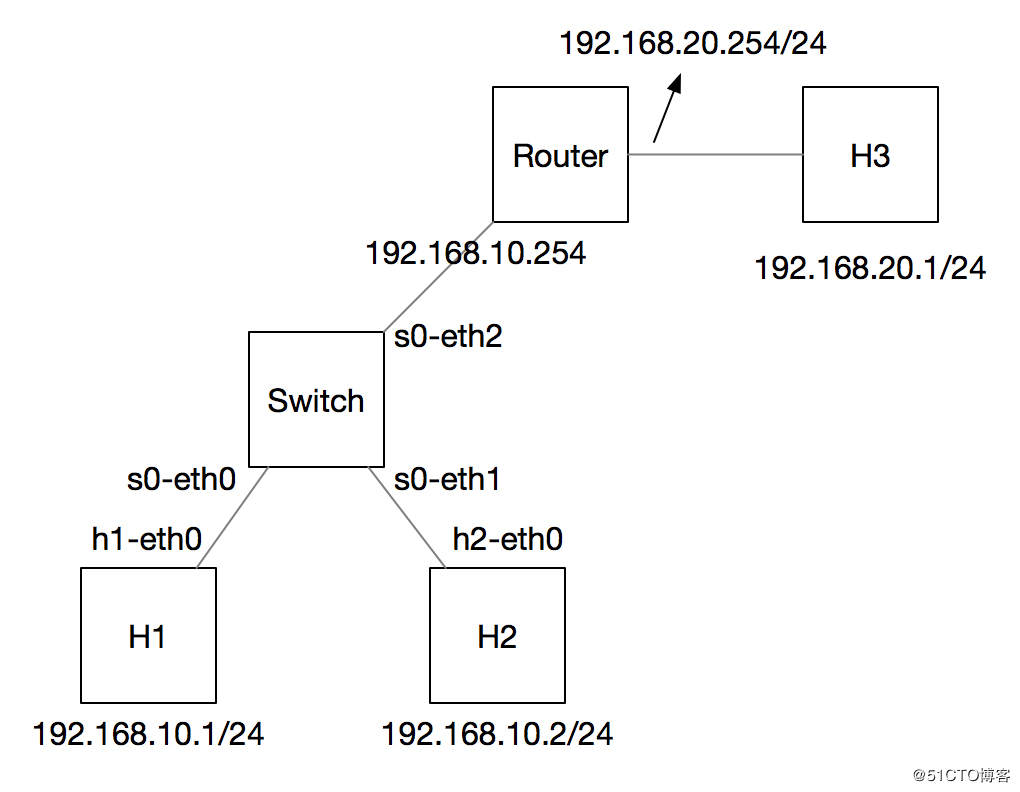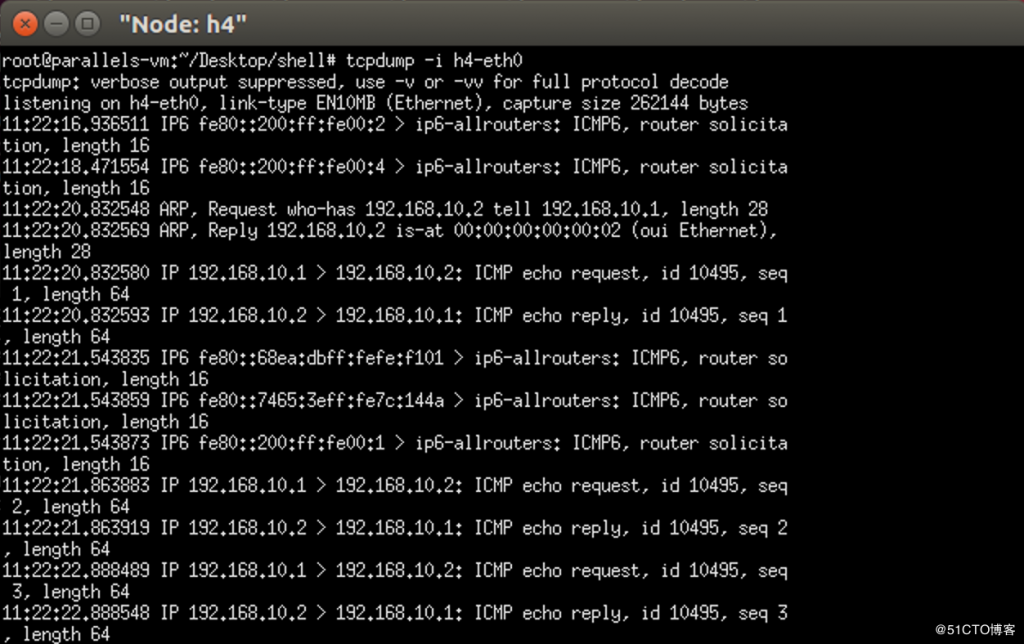In this tutorial, i will show you how to create a simple network topology including Hub, Router and Switch.
First experimental topology:
in this experiment, you need to type this command to install:
sudo apt-get install bridge utils
Base command:
brctl addbr br0 //add bridge(BRCTL = bridge control)
brctl addif br0 eth0 //Which current interface to add to the bridge (addif = add interface)
Here is my topology.py:
#!/usr/bin/env python
from mininet.cli import CLI
from mininet.net import Mininet
from mininet.link import Link,TCLink
if '__main__' == __name__ :
net = Mininet(link=TCLink)
h1 = net.addHost('h1', ip="192.168.10.1/24", mac="00:00:00:00:00:01")
h2 = net.addHost('h2', ip="192.168.10.2/24", mac="00:00:00:00:00:02")
h3 = net.addHost('h3', ip="192.168.20.1/24", mac="00:00:00:00:00:03")
r0 = net.addHost('r0')
s0 = net.addHost('s0')
net.addLink(h1,s0)
net.addLink(h2,s0)
net.addLink(s0,r0)
net.addLink(r0,h3)
net.build()
r0.cmd("echo 1 > /proc/sys/net/ipv4/ip_forward")
r0.cmd('ifconfig r0-eth0 192.168.10.254 netmask 255.255.255.0')
r0.cmd('ifconfig r0-eth1 192.168.20.254 netmask 255.255.255.0')
h1.cmd("ip route add default via 192.168.10.254 dev h1-eth0")
h2.cmd("ip rotue add default via 192.168.10.254 dev h2-eth0")
h3.cmd("ip route add default via 192.168.20.254 dev h3-eth0")
s0.cmd("brctl addbr br0")
s0.cmd("brctl addif br0 s0-eth0")
s0.cmd("brctl addif br0 s0-eth1")
s0.cmd("brctl addif br0 s0-eth2")
s0.cmd("ifconfig br0 up")
CLI(net)
net.stop()
echo 1 > /proc/sys/net/ipv4/ip_forward --> mean enable routing function.
ip rotue add default via 192.168.10.254 dev h2-eth0 -->setting default router.
The execution result:
parallels@parallels-vm:~/Desktop/shell$ sudo python topology.py
mininet> net
h1 h1-eth0:s0-eth0
h2 h2-eth0:s0-eth1
h3 h3-eth0:r0-eth1
r0 r0-eth0:s0-eth2 r0-eth1:h3-eth0
s0 s0-eth0:h1-eth0 s0-eth1:h2-eth0 s0-eth2:r0-eth0
mininet> nodes
available nodes are:
h1 h2 h3 r0 s0
mininet> links
h1-eth0<->s0-eth0 (OK OK)
h2-eth0<->s0-eth1 (OK OK)
s0-eth2<->r0-eth0 (OK OK)
r0-eth1<->h3-eth0 (OK OK)
Second experimental topology:
continuation experiment 1, i added h4 which opened hub function.
Here is my topology.py:
#!/usr/bin/env python
from mininet.cli import CLI
from mininet.net import Mininet
from mininet.link import Link,TCLink
if '__main__' == __name__ :
net = Mininet(link=TCLink)
h1 = net.addHost('h1', ip="192.168.10.1/24", mac="00:00:00:00:00:01")
h2 = net.addHost('h2', ip="192.168.10.2/24", mac="00:00:00:00:00:02")
h3 = net.addHost('h3', ip="192.168.20.1/24", mac="00:00:00:00:00:03")
h4 = net.addHost('h4', ip="192.168.10.3/24", mac="00:00:00:00:00:04")
r0 = net.addHost('r0')
s0 = net.addHost('s0')
net.addLink(h1, s0)
net.addLink(h2, s0)
net.addLink(s0, r0)
net.addLink(r0, h3)
net.addLink(s0, h4)
net.build()
r0.cmd("echo 1 > /proc/sys/net/ipv4/ip_forward")
r0.cmd('ifconfig r0-eth0 192.168.10.254 netmask 255.255.255.0')
r0.cmd('ifconfig r0-eth1 192.168.20.254 netmask 255.255.255.0')
h1.cmd("ip route add default via 192.168.10.254 dev h1-eth0")
h2.cmd("ip rotue add default via 192.168.10.254 dev h2-eth0")
h3.cmd("ip route add default via 192.168.20.254 dev h3-eth0")
h4.cmd("ip route add default via 192.168.10.254 dev h4-eth0")
s0.cmd("brctl addbr br0")
s0.cmd("brctl addif br0 s0-eth0")
s0.cmd("brctl addif br0 s0-eth1")
s0.cmd("brctl addif br0 s0-eth2")
s0.cmd("brctl addif br0 s0-eth3")
s0.cmd("brctl setageing br0 0")
s0.cmd("ifconfig br0 up")
CLI(net)
net.stop()

